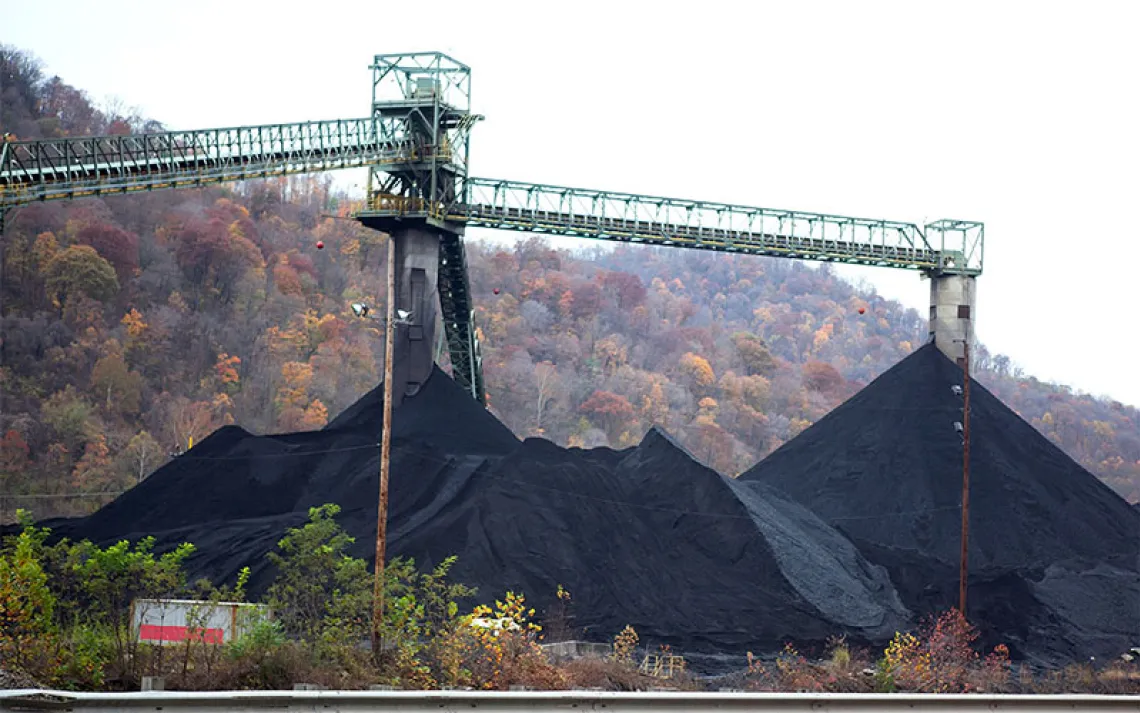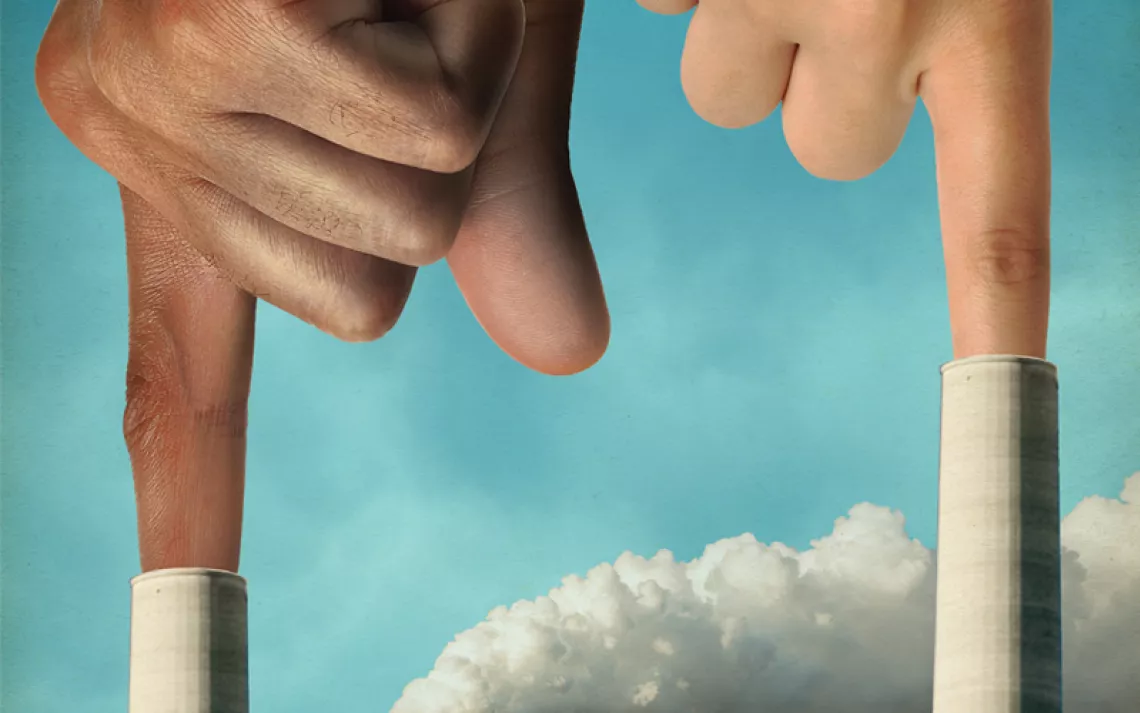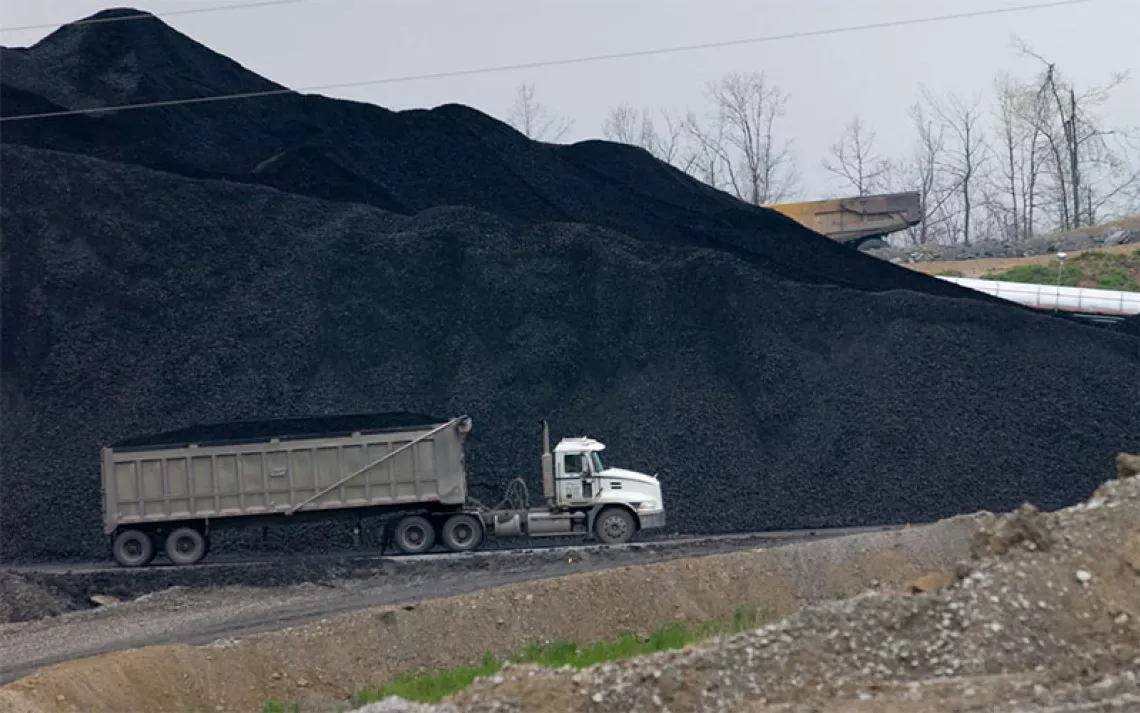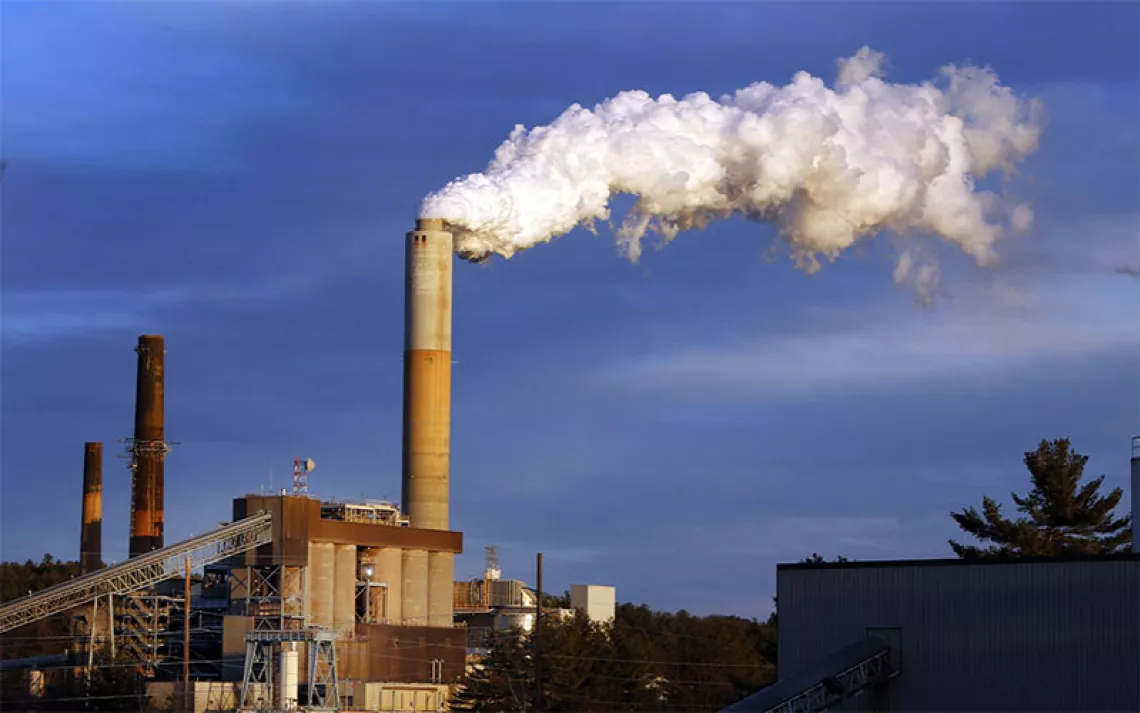The Coal Industry is Bankrupt
Coal companies are going under, banks won't lend money, mines are closing: The curtain's coming down on coal.
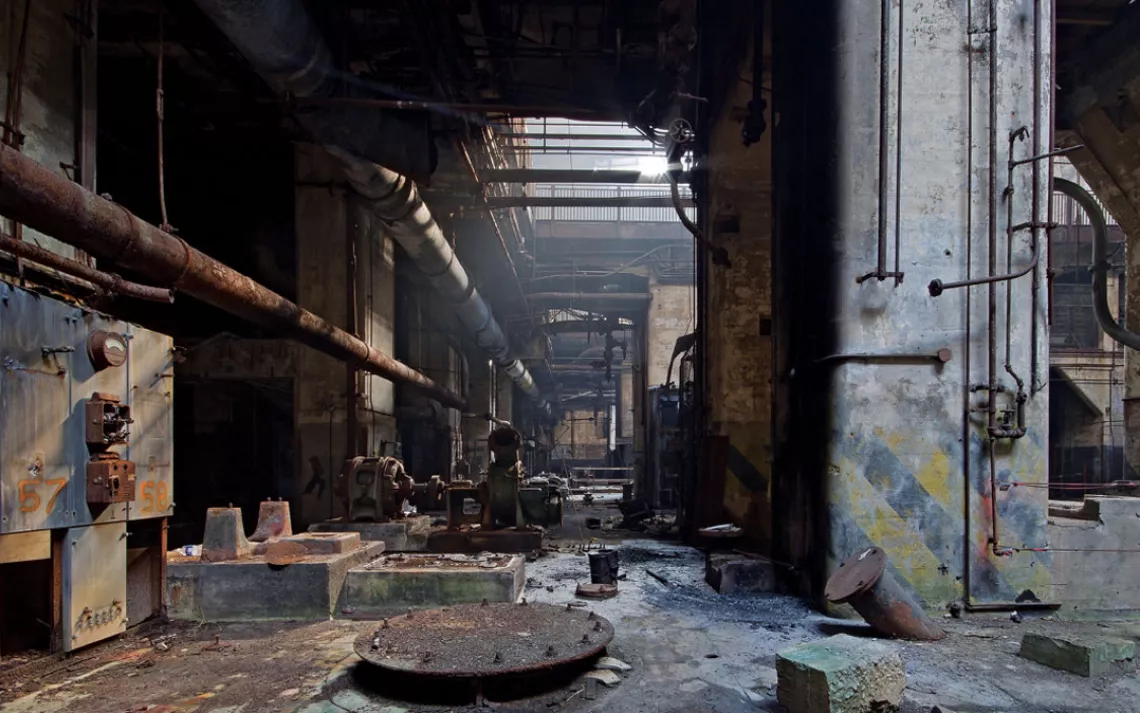
Philadelphia's coal-fired Delaware Generating Station was shuttered in 2004. The rest of the industry is set to follow. | Photo by Noah Levey.
Appalachian coal baron Don Blankenship once strode West Virginia like a colossus. The former CEO of Massey Energy shaped state politics, removed inconvenient judges, and micromanaged his dozens of coal mines to extract the maximum amount of coal with the least possible expenditure on safety for his workers—all while presenting himself as their champion. "Washington and state politicians have no idea how to improve miner safety," he told miner families at a 2009 Labor Day picnic. "The very idea that they care more about coal-miner safety than we do is as silly as global warming."
On April 5, 2010, a huge coal dust explosion at Massey's Upper Big Branch mine in West Virginia killed 29 miners. It was the deadliest U.S. mine disaster in 40 years. Blankenship insisted that the disaster was "an act of God," but juries found that Blankenship and his minions were to blame, and that their relentless focus on production and profit and apparent indifference to the health and safety of their miners had created the conditions that caused the explosion.
Three of Blankenship's underlings pleaded guilty and were sentenced to jail terms ranging from 10 to 42 months. A fourth was convicted of lying to investigators and destroying evidence; he was sentenced to three years. Blankenship himself was found guilty of a misdemeanor charge of conspiring to violate mine-safety standards, which carries a maximum penalty of one year in prison.
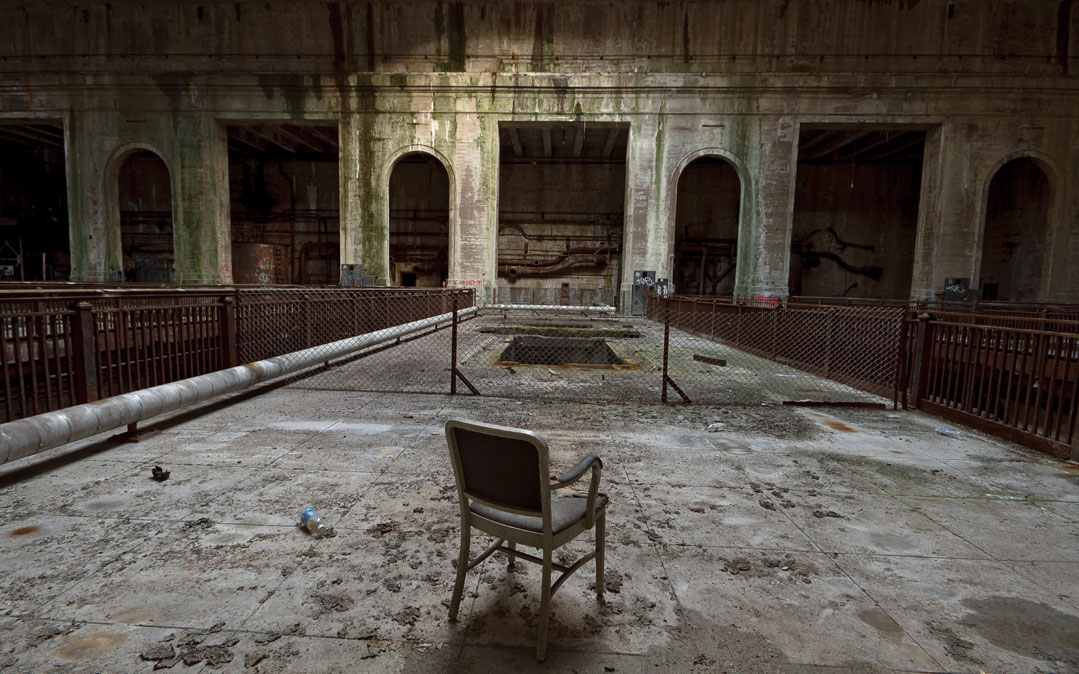 Inside the defunct Delaware Generating Station, now being dismantled by metal scrappers. | Photo by Noah Levey
Inside the defunct Delaware Generating Station, now being dismantled by metal scrappers. | Photo by Noah Levey
Blankenship's humbling mirrors that of his once-mighty industry. Coal's share of U.S. electric power generation has fallen from about 50 percent in 2007 to about 33 percent today. At a conference sponsored by the Texas Public Policy Foundation, Robert Murray—CEO of the privately held Murray Energy of Clairsville, Ohio—said, "The industry is bankrupt. Our coal markets are being destroyed." Should the new emissions regulations proposed under the Obama administration's Clean Power Plan take effect, predicts the Energy Information Administration (EIA), they will knock down coal's share farther still. In a report called Coal Industry North America: Lights Go Dim on Coal, Moody's Investors Service noted that the industry's gross earnings fell by 25 percent in 2015 and will likely drop by another 10 percent this year.
"The coal industry fundamentals remain very bleak in my opinion," says Matthew Miller, a coal industry analyst with S&P Global Market Intelligence. "If there is a light at the end of the tunnel, we can't see it yet."
The coal industry has been battered hard by market forces. Technological advances have made natural gas, wind, and solar—and efficiency—increasingly competitive. The once-robust overseas demand for coal is disappearing. And a decade of sustained public advocacy for clean air and clean energy has changed the rules of the game (see "Power From the People"). Stringent new regulations that require power plants to stop endangering public health impose substantial new costs on an industry that has had a free ride for many years. According to Miller, it is unlikely that another coal-fired electric power plant will be built in the United States.
Since 2010, 232 U.S. coal plants have been shuttered or scheduled for retirement—one-third of the U.S. fleet. Grassroots activism stopped another 184 plants from being built. In 2015, coal capacity retirements took about 13,000 megawatts offline, according to the EIA. New natural-gas-fired plants replaced about 4,300 of those megawatts. The American Wind Energy Association says that about 8,600 megawatts of wind capacity were installed in 2015, and the Solar Energy Industry Association claims nearly 7,300 megawatts. That brings the total installed solar capacity in the United States to 20 gigawatts—enough to power 4 million homes. Many more coal plants are slated for retirement. Analysts with the Sierra Club's Beyond Coal campaign have tallied 50,000 megawatts of coal-based power generation slated to sunset by 2030. Even so, two-thirds of U.S. coal plants are still up and running, and their impending closure is by no means a foregone conclusion. The trajectory for the coal industry is clear, but the timeline is not.
A major factor in coal's ongoing collapse has been the development of new technologies like horizontal drilling and hydraulic fracturing, which have made it easier and cheaper to get natural gas out of the ground. The relative prices of the fuels over the past decade tell the story: In 2005, the spot price of coal per million British thermal units (Btu) was $1.54, and gas's high was $13.05. Ten years on, gas had dropped to $1.93 per million Btu, while coal had risen to $2.23. Accordingly, the natural gas share of electric power generation during that period rose from 19 percent to 32 percent. (While natural gas does burn cleaner than coal, environmentalists say that its many negatives—fracking's propensity to poison water and cause earthquakes, methane leakage during production, release of greenhouse gases at power plants, and the displacement of renewable energy—make it a poor substitute for coal.)
Coal's decline extends beyond the United States: Many countries that used to be reliable customers for U.S. coal just aren't into it anymore, partly because of last year's successful UN climate change conference in Paris. The goal established there—to keep global temperatures from rising more than 1.5°C—will require a rapid worldwide shift from coal. That migration was already under way when the Paris conference started; U.S. coal exports fell from 126 million tons in 2012 to 97 million in 2014. China, the world's largest producer and consumer of coal, has been reducing its coal use since 2013, in part because the air in its larger cities is at times unsafe to breathe. China imported 1.7 million tons of U.S. coal in 2014 but only 229,000 tons in 2015, a reduction of 86.5 percent.
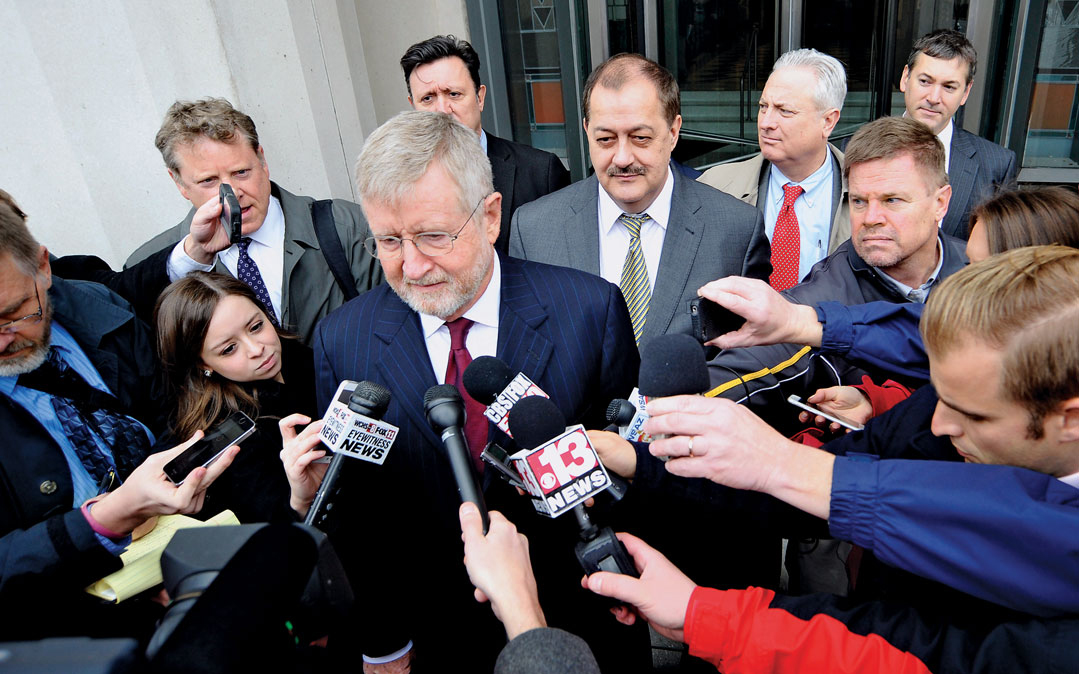
Former Massey Energy CEO Don Blankenship (behind his attorney) outside the West Virginia courthouse where he was found guilty of conspiracy to violate mine-safety standards. | Photo by Chris Tilley/Reuters Pictures.
Cloud Peak Energy of Gillette, Wyoming, used to export coal from its Powder River Basin mines in Wyoming and Montana to China but started losing money on those exports in 2013. "Last fall, the losses got so bad that Cloud Peak decided to halt all exports," says Clark Williams-Derry of Seattle's Sightline Institute think tank, "even though it's still contractually obligated to pay steep penalties to rail and port companies for not shipping coal." The company loses more money by exporting coal than by doing nothing.
Even companies that still want to export coal are finding it difficult to ship their product out, as climate and community-health activists are blocking the construction of export facilities up and down the West Coast. Planned coal terminals at Cherry Point and in Longview, Washington; in Boardman, Oregon; and in Oakland, California, either have been abandoned or are mired in litigation—while Asian demand softens and the economic rationale for the ports drifts away with the Pacific fogs.
Pummeled by these blows, the giants of the coal industry are toppling. In August 2015, Alpha Natural Resources of Richmond, Virginia, filed for bankruptcy, seeking to sell 26 of its coal mines and laying off about 4,000 workers. The company reported that it was $4 billion in debt.
Alpha executives seem intent on making the bankruptcy as painless as possible, at least for themselves. The company asked the court's permission to pay 15 of its executives $11.9 million in bonuses while it cuts medical and life insurance benefits to company retirees. Judge Kevin Huennekens granted the bonus request over the fervent objections of the U.S. Justice Department but put off ruling on the retirees until April 12 (after Sierra's deadline). If he grants the request, 4,580 retired miners and family members will lose their coverage, and about 6,670 active employees will lose their retirement benefits, according to Wyoming's Casper Star Tribune.
Alpha was followed by Arch Coal Inc., the second-largest coal supplier in the United States, which filed for bankruptcy protection on January 11. The St. Louis–based company, with 5,000 employees, said it was $4.5 billion in debt.
Peabody Energy Corp., the world's largest private-sector coal company, may be the next to go. Its stock took a nosedive from $103.50 per share in January 2015 to $6.66 a year later. All three bond rating services—Fitch, Moody's, and S&P—have rated Peabody's bonds as junk.
While the rise of natural gas and renewables and the fall of exports exert terrible market pressure on coal, industry leaders prefer to blame their woes on President Barack Obama. "I think he's doing more damage to this country than a terrorist could do," coal baron Murray told the Washington Times.
The crucial actions taken by Obama's EPA to regulate coal, however—standards governing mercury, coal ash, sulfur dioxide, and air and water toxics, as well as the Clean Power Plan itself—were the results of court orders. Those, in turn, were largely due to decades of public pressure and litigation by clean energy advocates, including the Sierra Club. These regulations resulted in the closure of many of the dirtiest coal plants as coal operators, often under intense pressure from communities and advocates, opted to retire the plants rather than install the necessary pollution controls.
The most sweeping of these regulations, the Clean Power Plan, was expressly designed to ratchet down carbon emissions from electric power plants by 32 percent from 2005 levels by 2030. Each state has been given a reduction target based on its particular mix of energy sources—coal, natural gas, nuclear, wind, and solar—and the volume of its carbon emissions.
Murray Energy and 26 states sued the EPA over the plan. "The EPA's rule is flatly illegal and one of the most aggressive executive branch power grabs we've seen in a long time," said West Virginia attorney general Patrick Morrisey. The petitioners asked the U.S. Court of Appeals for the D.C. Circuit to suspend implementation of the plan. The court denied that request, but, in a surprise move in February, the conservative majority on the Supreme Court granted it. The plan will now make its way through the court system until the Supreme Court rules on the merits, in the summer of 2017 at the earliest—a process further complicated by the death of Justice Antonin Scalia. Meanwhile, many states and utilities have pledged to continue their transition to clean energy.
On a separate track, the EPA is beginning to enforce a 2010 health standard governing sulfur dioxide pollution and finalizing a regulation to reduce the interstate air flow of nitrogen oxides; both compounds are byproducts of coal combustion. These measures may require some plants to be retrofitted with scrubbers, which may in turn reduce their cost competitiveness.
Finally, on January 15, the administration announced a temporary halt to new coal-mining leases on federal land, pending a review of the leasing program. At present, 40 percent of U.S. coal is extracted from federal land, and the Sierra Club and other environmental groups have long called for reform of the program. The Interior Department said that it wants to revisit the amount mining companies pay to dig for coal on public land, which hasn't changed since 1975. (The Government Accountability Office recommended in 2014 that Bureau of Land Management offices tighten up the way they estimate fair market value.) According to the BLM, at least 30 applications for new mining leases have been suspended.
More worrisome still for the coal industry, the Interior Department said it also wanted to consider the coal-leasing program's effect on human health and the environment—another longtime goal of clean-air and lands-protection activists. It expects the review to take about three years, so whether or not the public continues to subsidize climate change will depend in part on who is president three years hence. For decades, the coal industry and its apologists have promised that so-called clean coal technology would be the industry's salvation. Carbon from burning coal would be captured in the power plants and then safely "sequestered" in deep mines. The only problem is that there isn't a single U.S. coal plant using that technology today, and only two are under construction.
Coal burning is the source of about 30 percent of U.S. greenhouse gas emissions, but coal producers "haven't worked very hard" to advance clean coal technology, says Steve Piper, associate director of energy fundamentals at SNL, a research firm. Rather, they've left it up to the electric power industry and the federal government to do the legwork. The government has been funding clean coal research for years via loan guarantee and tax incentives; according to the Congressional Research Service, Congress has given the Department of Energy more than $6 billion for carbon capture and storage (CCS) research since 2008.
So far, it has gotten zero return on its investment. "Nobody is switching to CCS," says Evan Hansen, an energy analyst with Downstream Strategies in Morgantown, West Virginia. "It's not a proven or economical technology." "Coal is coal, and I don't know how much cleaner you can actually make coal," says Miller of S&P Global Market Intelligence. "There are obviously other energy sources that are cleaner than coal."
In the aftermath of the Supreme Court's surprise stay of the Obama administration's Clean Power Plan, some coal supporters imagined a coal renaissance around the corner. "We are thrilled that the Supreme Court realized the rule's immediate impact and froze its implementation, protecting workers and saving countless dollars as our fight against its legality continues," West Virginia attorney general Morrisey said.
Most analysts, however, agree that the fundamentals have not changed. David Schlissel and Tom Sanzillo of the Institute for Energy Economics and Financial Analysis, a Cleveland think tank, point out that the stay will not affect market competition, boost coal exports, or lower maintenance costs on antiquated plants. "These forces will also continue to undercut the coal industry in the years and decades ahead," they write. "The market, it seems, has already spoken."
This article was funded by the Sierra Club's Beyond Coal campaign.
This article has been corrected.
Beyond Coal: Power From the People
The Supreme Court may have temporarily paused the Clean Power Plan, but it hasn't paused the decline of the coal industry, the United States' transition to clean energy, or our progress toward meeting the climate commitment we made in Paris. That progress is due to a grassroots movement that is resilient, nimble, and powerful.
Since 2002, Sierra Club activists have been among the hundreds of organizations and community leaders who have come together to stop the construction of 184 proposed new coal plants, secure the retirement of one-third of the nation's existing coal plants (232 and counting), and help replace that coal power with clean, renewable energy.
Together, we've closed or shrunk a century's worth of federal coal-pollution loopholes, as the EPA has set long-overdue standards for mercury, sulfur dioxide, coal ash, water toxics, and carbon pollution. We are there on the ground every time a utility is called on to clean up its pollution, pushing for it to retire its coal plants and shift instead to renewable energy and efficiency.
In the five years that Beyond Coal has focused on coal plant retirements, coal has dropped from providing half of our nation's power to one-third of it. The coal industry's political clout has plummeted accordingly, creating the space for a thriving clean energy industry and setting the stage for U.S. climate leadership. Now, U.S. carbon emissions are at their lowest level in two decades. Every year we're preventing 6,000 premature deaths and 100,000 asthma attacks.
We have our sights set on securing the replacement of half of the remaining U.S. coal with clean energy by 2017. What keeps us moving forward is our proven strategy of mobilizing a diverse grassroots movement. I hope you'll join us—learn more at beyondcoal.org and @beyondcoal on Twitter.
—Mary Anne Hitt, director of the Sierra Club's Beyond Coal campaign
 The Magazine of The Sierra Club
The Magazine of The Sierra Club
